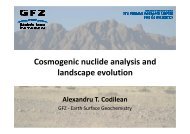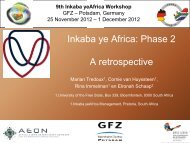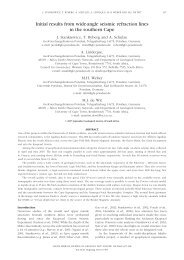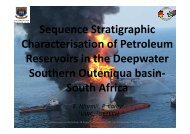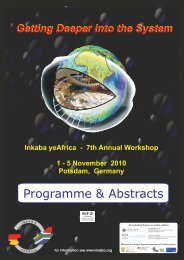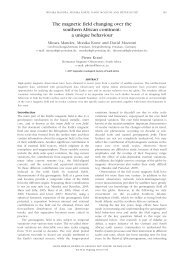South Africa - Inkaba.org
South Africa - Inkaba.org
South Africa - Inkaba.org
Create successful ePaper yourself
Turn your PDF publications into a flip-book with our unique Google optimized e-Paper software.
Seismicity and Seismic Hazard Assessment of the arid western<br />
regions of <strong>South</strong> <strong>Africa</strong>: a Neotectonic Perspective<br />
H R Malephane 1 , R J Durrheim 1, 2 , M A G Andreoli 1, 3<br />
1. University of Witwatersrand, <strong>South</strong> <strong>Africa</strong>, hlompho.malephane@students.wits.ac.za<br />
2. Council for Scientific and Industrial Research, <strong>South</strong> <strong>Africa</strong>, rdurrhei@csir.co.za<br />
3. <strong>South</strong> <strong>Africa</strong>n Nuclear Energy Corporation, <strong>South</strong> <strong>Africa</strong>, marco@necsa.co.za<br />
ABSTRACT<br />
There are two nuclear reactors in <strong>South</strong> <strong>Africa</strong>, a research reactor at Pelindaba near Pretoria and a powergenerating<br />
reactor at Koeberg near Cape Town. High level radioactive waste (HLW) in the form of spent fuel is<br />
currently stored in the designated spent-fuel pools on the Koeberg site. The shorter lived, low- and intermediatelevel<br />
waste (half-life ≤31 years) is sent to the Vaalputs National Radioactive Waste Disposal Facility in the<br />
Northern Cape Province, currently managed by the <strong>South</strong> <strong>Africa</strong>n Nuclear Energy Corporation (Necsa). In<br />
addition, the <strong>South</strong> <strong>Africa</strong>n government is currently formulating plans to construct additional nuclear power<br />
stations to meet future demands for energy. According to the Radioactive Waste Management Policy and Strategy<br />
for the Republic of <strong>South</strong> <strong>Africa</strong> it is prudent to begin gathering the data needed to assess future HLW disposal<br />
sites, and explore other options like the reprocessing of spent nuclear fuel.<br />
Site selection criteria for a nuclear waste disposal site include proximity to settlements, agricultural potential of<br />
land, geological stability and seismic activity. This study will make a detailed investigation of the seismic activity<br />
in the arid western region of <strong>South</strong> <strong>Africa</strong>, as this region is likely to prove suitable, in principle, for the disposal of<br />
radioactive waste. It is planned to expand and link the existing seismic network at Vaalputs to the National<br />
Seismograph Network stations which should improve the sensitivity and location accuracy of the Bushmanland<br />
region.<br />
The current Necsa seismic database shows that the Vaalputs site is seismically stable, yet there has been sporadic<br />
seismic activity in Namaqualand with swarms in 1996, 2001, and again (near Augrabies) in 2010. The network will<br />
be used to assess the reliability of the reported magnitudes, to define active faults and seismotectonic zones, and to<br />
derive seismic source mechanisms. This will yield more accurate seismic hazard assessments.<br />
KEYWORDS: nuclear waste disposal, <strong>South</strong> <strong>Africa</strong>, seismicity, neotectonics, seismic hazard assessment<br />
49



